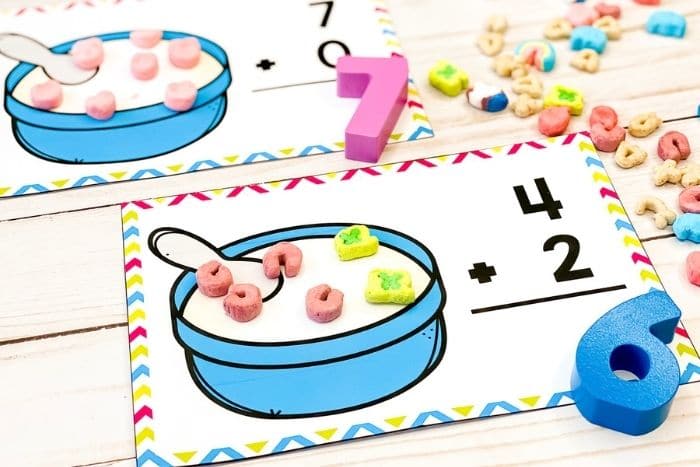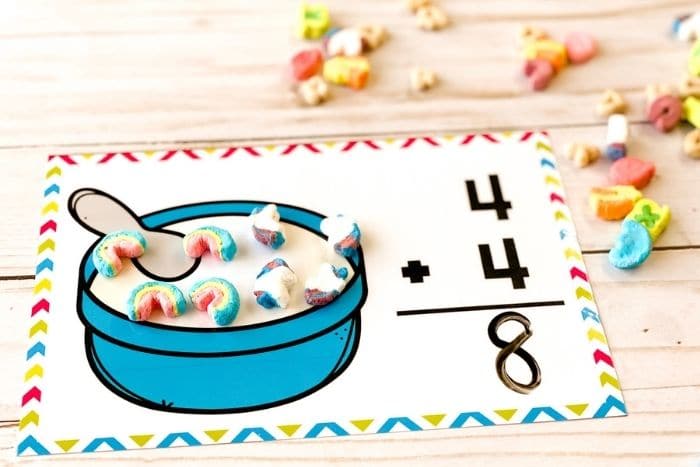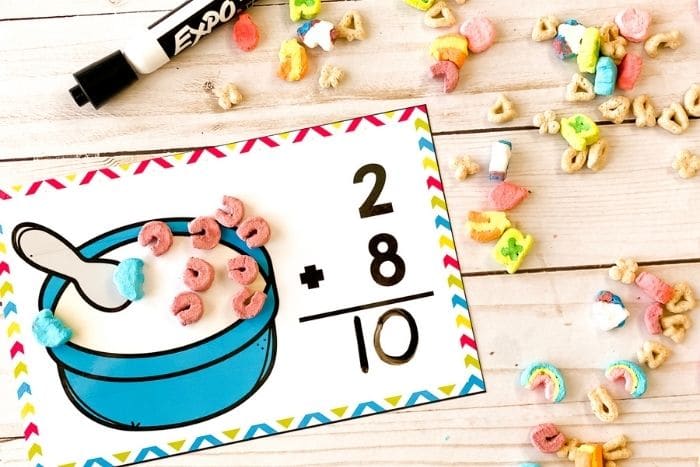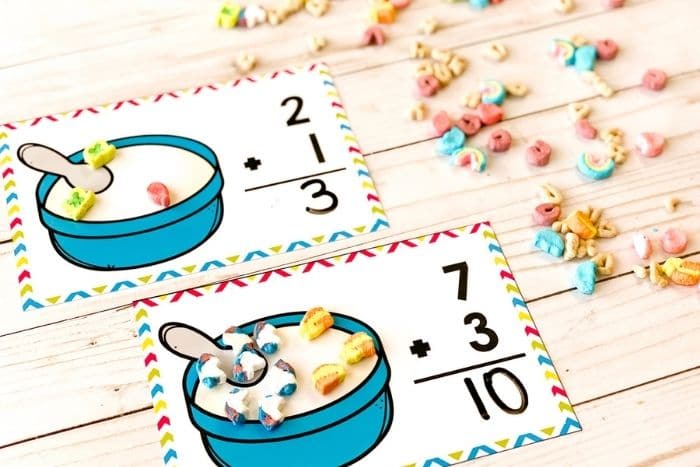Free Printable Marshmallow Addition Mats for Kindergarten
It’s so important for young learners to really UNDERSTAND addition and subtraction! They need to SEE it, TOUCH it, SMELL it (sorry, got carried away)! But seriously, hands-on activities in early math are truly mandatory in preschool, kindergarten, and even beyond. Check out the FREE Marshmallow Addition Math Mats for Kindergarten to help support your students’ understanding of addition problems. All you need to do is print, cut, and protect the free printable.

Recommended Grade Level:
How to Teach Addition in Kindergarten
MATH MAT ACTIVITIES FOR KINDERGARTEN
TEACHING ADDITION IN KINDERGARTEN REQUIRES HANDS-ON PRACTICE AND REPETITION THROUGHOUT THE ENTIRE SCHOOL YEAR.
We want to expose children to addition in kindergarten so they can begin mastering the basic facts in first grade. However, there are some prerequisite skills that should be in place before delving into that addition practice in kindergarten.
Place it at the math center, work with small groups, turn it into a game, or put another spin on it! These work mats are super versatile, and will meet the needs of all learners!
This activity was designed with a yummy marshmallow cereal in mind. However, mini erasers, buttons, beads, or other countable objects also work!
Here are the facts included in this free printable math addition worksheet for kindergarten: 10+1, 10+5, 2+8, 7+3, 4+6, 5+5, 8+1, 3+6, 2+6, 4+4, 7+0, 2+5, 4+2, 1+5, 4+1, 3+2, 4+0, 2+1, 1+1, 1+0.
Prerequisite skills for addition include:
- Count fluently to at least 20
- Count groups of objects up to 20
- Recognize numerals 0-20
- Match numbers with a group of objects
- Write the numerals 1-20
When those skills are in place, pull out the addition math centers for kindergarten!

What Can Kindergarteners Learn While Adding With Marshmallows?
ADDITION MATS FOR KINDERGARTEN
WHILE WE MIGHT USE THE MARSHMALLOWS TO DRAW KIDS’ INTEREST, THEY WILL BE LEARNING SO MUCH WITH THIS INTERACTIVE LEARNING MAT!
Addition mats area great way for children to SEE the concept of adding in action. This helps them develop number sense and other important skills:
- Counting on
- Subitizing
- One-to-one corresondence
- Number writing

Why Is It Important For Kids To Learn Basic Math Facts?
Fluency and automaticity with basic facts provides a solid foundation for students, making them ready for more complex tasks.
Number Sense: Playing math games improves number sense which is the ability to understand, compare/contrast, and relate numbers to each other.
Automaticity: When children effortlessly (automatically) know basic math facts, it makes more complex computations easier.
Vocabulary: Encouraging kids to use math vocabulary while playing games (sum/difference/total/greater than/less than)is a meaningful way to practice.
Cooperative Learning: Simple games with partners or small groups give kids a lot of practice with social skills, like taking turns, following rules, and winning/losing.
How to Make The Marshmallow Addition Activity for Kindergarten
Step One:
Print and laminate the printable math mats for addition. Then, just decide how to use them with your students. There are multiple ways to make this work for a diverse bunch of learners!
Step Two:
Each full-page printable includes two math mats. Cut the pages in half to limit it to one addition sentence per mat.
Step Three:
To play, students should read the math fact aloud. Then, add each number of marshmallows to the bowl. Finally, count the total number of marshmallows to find the sum. Write the sum under the line and repeat.

Step Four:
Remember those prerequisite skills mentioned above? If your students aren’t quite there yet, try this:
- Instead of adding the numbers in the provided equation, pull it apart. Ask students to count objects into the bowl for the top number, then do the same for the bottom number. Finally, they can count the total number of objects.
- Place the first number of objects INTO the bowl, then instruct students to place the second number ON the bowl to create separation. Then, push all the objects into the bowl and count the total.

Step Five:
Wondering about those students who can already add with a bit of ease? Try this:
- Have the students start with the top number in their heads, then count the bottom by adding objects onto the mat to find the sum.
- Try starting with the bigger number instead of the top number, to teach students a more effective addition strategy.
Extend the Activity
Number Bonds
Number bond mats show addition in a different way! When we take out the equation symbols and just show the relationship between the numbers, it can be very helpful for young learners. Students can roll a die or draw number cards to begin the bond, then add them up to complete it.
Number Stories
Turn any math worksheet or flash cards into an interactive story problem by asking students to take turns making up a story to go with each problem.
Dice Game
Roll and Add is a simple math game to practice addition problems in kindergarten. It requires a whiteboard, a dry erase marker, and two dice. Just roll the dice, write the math fact, and find the sum. Students can compete by getting a point for the student with the higher sum each round.

join the newsletter & Get your free activity
Get Your Free Printable Activity Here!
Already a subscriber? No worries. Just enter your email here to have the activity sent directly to your inbox.

More Food Theme Activities!
Don’t stop here! Seriously, what kid doesn’t love playing with their food? So, naturally, learning with their food has to be a favorite too…
Get even more food activities below!
>>101 Food Activities for Kids<<
More Marshmallow Counting You’ll Love:
Looking For More Counting Activities?
Need Even More Counting Mats?
- Restaurant Theme Counting Mats
- DUPLO Counting Mats
- Hot Chocolate Counting Mats
- Spider Web Counting Mats
- Tree Play Dough Counting Mats
Search All Activities
Looking for more? Find exactly what you need here:

















